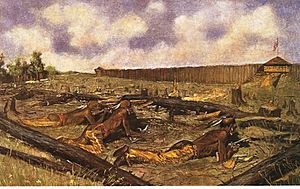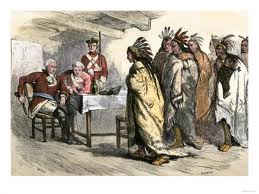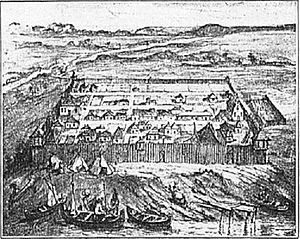Siege of Fort Detroit facts for kids
Quick facts for kids Siege of Fort Detroit |
|||||||
|---|---|---|---|---|---|---|---|
| Part of Pontiac's Rebellion | |||||||
 The Siege of the Fort at Detroit by Frederic Remington |
|||||||
|
|||||||
| Belligerents | |||||||
| Pontiac's confederacy | |||||||
| Commanders and leaders | |||||||
| Pontiac Wasson |
Henry Gladwin Donald Campbell † |
||||||
The siege of Fort Detroit was a long fight where Native American tribes tried to take over Fort Detroit. This happened during Pontiac's War, also known as Pontiac's Rebellion. The main leader of this effort was Pontiac, a powerful chief from the Ottawa people.
This rebellion was one of the big reasons for the Royal Proclamation of 1763. This proclamation later helped lead to the American Revolution.
Contents
Why the Siege Happened
Fort Detroit was a very important place. The British took control of it from the French in 1760. This happened during the French and Indian War. The land around the fort was given to Great Britain in the Treaty of Paris in 1763.
Native American tribes like the Ottawas, Pottawatomis, Hurons, and Chippewas had been friends with the French. They were promised goods like blankets and gunpowder. But when the British took over, things changed. The British did not offer as many gifts or good trade prices. This made the Native Americans very unhappy. They felt cheated and mistreated.
Sir William Johnson, a British official, tried to make peace. He offered gifts like garden hoes and promised lower prices. He even offered a doctor and a gunsmith at the fort. But the Native Americans still did not trust the British.
Pontiac, a respected Ottawa chief, saw this anger. He decided to unite the tribes against the British. On April 27, 1763, Pontiac held a meeting near the Ecorse River. He convinced the Pottawatomi, Hurons, and Chippewas to join his Ottawa warriors. Their plan was to attack the British fort.
Pontiac was a strong leader. He was born into the Ojibwa and Ottawa tribes. He had fought in the French and Indian War. He was about 40 to 50 years old when the siege began.
Pontiac's First Attack Plan
Before a big attack, Pontiac went to Fort Detroit. He brought 40-50 Ottawa warriors with him. He wanted to see how strong the fort was and find places to take supplies.
Pontiac pretended to visit the British officers. While he danced, ten of his men secretly looked around the fort. On May 6, a small British group was attacked near the St. Clair River. Some were captured, and some were killed.
On May 7, Pontiac returned with about 300 men. They had weapons hidden under their blankets. Pontiac planned to give a speech to Major Henry Gladwin, the British commander. When Pontiac gave a signal, his men would attack. Other warriors would surround the fort.
However, Major Gladwin had found out about Pontiac's plan. The British soldiers, about 120 of them, were ready. Pontiac saw this and left. Two days later, on May 9, he started the actual siege. Pontiac came back with 64 canoes full of his warriors. He demanded to be let in to talk with Major Gladwin. Gladwin only allowed Pontiac to enter. This made Pontiac give up his secret plan and begin the siege.
Right after the siege began, many British soldiers and people outside the fort were captured or killed. The attacks were only on the British. French settlers were not harmed. Soon, over 900 Native American warriors from several tribes joined the siege.
The Siege Begins
Pontiac set up his camp two miles north of Fort Detroit. This spot was near what is now Bloody Run Creek. This creek would later be the site of a major ambush.
Pontiac tried to talk peace with two British officers. He held them hostage during the talks. When peace talks failed, Pontiac attacked the fort again. But his weapons could not break through the strong fort walls. His forces then moved back. This allowed the British to come out and clear away trees and fences. These could have been used as cover by the Native Americans.
Fort Detroit was a square-shaped fort. It had strong wooden walls called a palisade. Cannons and mortars were on its bastions (strong corners). About 2,500 people lived inside the fort. There were 120 fighting men. These included soldiers from the 60th Royal American and Queen's Rangers. There were also armed traders and loyal Frenchmen.
Supplies at the fort were running low. They only had ten days of food left. Outside the fort, on the Detroit River, were two ships. The schooner Huron had six cannons. The sloop Michigan had ten cannons.
The British needed more supplies and soldiers. A group of about 100 men set out on Lake Erie to reach Fort Detroit. Some of them escaped an attack and went to Fort Sandusky. They found it destroyed and returned to Fort Niagara. The Native Americans took their captives to Detroit. The bodies were later put into the river to float past the fort. This made the British soldiers inside feel very sad and scared.
A group of small boats led by Lieutenant Cuyler was ambushed at the mouth of the Detroit River. Only 40 men, including Lieutenant Cuyler, escaped. About 60 were killed or captured. This fight became known as the Battle of Point Pelee.
Soon after, the schooner Huron fought off an attack by canoes. Fourteen of Pontiac's men were killed. The British had no losses. The ships were attacked again on July 9. Pontiac sent small boats filled with burning sticks and tar. He hoped to set the wooden ships on fire. But the ships dodged the burning boats. The same thing happened the next night, but Pontiac's attacks failed.
On July 29, 260 British soldiers arrived to help Fort Detroit. They were led by Captain James Dalyell. Robert Rogers, a famous British Ranger, also came with his Queen's Rangers.
Battle of Bloody Run
The day after arriving, Captain Dalyell convinced Major Gladwin to let him attack Pontiac's camp. Dalyell took 247 soldiers. They started out at 2:30 AM towards Parent's Creek (now Bloody Run Creek).
However, Pontiac's men knew they were coming. French spies had warned them. Pontiac set a trap. He sent 150 warriors to ambush the British. Another 250 warriors blocked the British retreat back to the fort.
When the British crossed the river, they were met with a lot of gunfire. They became confused and retreated. The British eventually broke through Pontiac's trap. They captured a local barn for cover. They fought their way back to the fort doors. This battle cost them 23 dead soldiers and 34 wounded. Captain Dalyell was also killed.
The Siege Ends
The fort held strong through the summer and fall. Neither side wanted to lose more men. The situation was a stalemate, meaning neither side could win. Pontiac's power among his followers began to weaken. Some Native American groups started to leave the siege. Some even made peace with the British before going home.
On October 31, 1763, Pontiac finally realized that the French in Illinois would not help him. He ended the siege and moved south to the Maumee River. He continued to try and unite tribes against the British there.
Pontiac's attempt to take Fort Detroit failed. It did not change the way the British and Native Americans lived together before the war. Native American life was greatly affected. They lost many people and chances to trade. For the British, this meant they could focus on their colonies along the coast. The areas further inland were mostly peaceful.
Later in October 1763, the Royal Proclamation of 1763 was declared. This changed how the British managed the American frontier. These changes eventually led to the American Revolutionary War.



